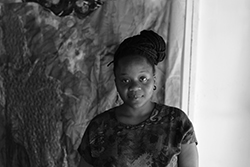
You are warmly invited to attend an Open Studio with RAW Artist in Residence, Kresiah Mukwazhi, to view her new work, “Although I am young, I am the mother of this house”. This is an opportunity to engage directly with the artist, and to learn about her work and her process.
Thursday 15 August 2019 @ 12:00 noon
RAW Spot Gallery
5 Rhodes Avenue (Corner of Lucas Ave, opposite the Health Care Centre)
Kresiah Mukwazhi is a Harare-based artist who is a Fellow of the “Arts of Africa and Global Souths” Residencies for Artists and Writers (RAW) programme in the Fine Art Department. During the National Arts Festival she performed “Summoned from Luzari” as part of the Arts Lounge festival programme.
Kresiah is a graduate of the National Gallery School of Visual Art and Design in Zimbabwe, as well as the Market Photo Workshop in South Africa. She is a multidisciplinary artist whose artistic practice draws on personal experiences and observations of gender-based violence, exploitation and abuse. She uses women’s undergarments in her practice and makes use of the material’s associative power as a form of resistance.
ARTIST’S STATEMENT:
The installation, Although I am young, I am the mother of this house, involves the performance of the body, found objects, textiles and words, and considers the ways in which these aspects can be practiced as forms of resistance. This work seeks to open the conversation of safety and freedom, and to comment on how we navigate space as women, knowing that we are constantly targets of assault. It also seeks to bring a sense of relief and healing to the trauma of a violent experience.
Through this installation, I refer to my 2017 documentary research of sex workers residing in Hopely Farm, which is one of the poorest suburbs in Zimbabwe. The shantytown comprises of five compounds, and in each of these there are at least 30 women selling sex. When I was there, I observed the casual loose-tongue and the powerful statements written on the wall hangings of these women. I became more intrigued when I grew to understand that the loose-tongue was their way of disempowering the vulgar language so often directed at them by the public. The same kind of attitude can be felt in the wall hangings, which are composed of provocative language in vernacular or English. At times a photo is inserted for emphasis.
Although I am young, I am the mother of this house is an imagined safe space, an attitude of thick skin and the performance of seeing my body as some sort of home. I am generally interested in textiles as a form of expression because my mother used to make clothes. She adorned the house with tapestries common in many African homes, and that inspired me a lot. The use of embroidery, silky and textured textiles is an attempt to bring notions of being in a personal space. Where is this place where one can feel safe and free to express oneself without persecution or fear?
Creating artwork in a small town like Makhanda has its challenges in terms of sourcing materials, so I allowed this space to guide the process. As such, my process became very organic and experimental. This is how I arrived at including embroidered wall hangings as part of the work. This work exists between the uncertainty of my freedom as an artist and issues of my safety and security as a woman. The barbed wire and bra straps perform the trauma of this dilemma, presenting evidence of an attempted escape.
I use a lot of props in this work, most of which are purchased from Chinese shops. In 2008, my country faced an economic crumble which was followed by a rapid rise of the cost of living. The average person would use a Chinese product whether in the form of toiletries, clothing, cars, hair extensions, etc. Ironically, the use or purchase of these products was looked down upon because of their cheap and poor quality. There was also an increase in the number of second-hand clothing bales, street boutiques (kwakotamai) where I usually source the bras that I use as material in my sculptural work. The main market place where these bale stalls could be found is still functional today and is called ‘Mupedzanhamo’, which can be translated as, ‘one who ends poverty’. Together, these objects of resistance perform and comment on the female narrative of the social ills my people are going through.
Recently I've been on a path to experiment more with light. In this installation I use light to illuminate the work, creating a sense of safety in a dark space. What I am trying to express and reveal is that to resist is powerful, but it also makes one a target for victimization. I come from a society that stereotypes and looks down upon unmarried women that are no longer virgins. Feminists, single mothers, sex workers, are often perceived as ‘wilfully loose’. Although I am young, I am the mother of this house seeks to disempower this patriarchal mind set.
